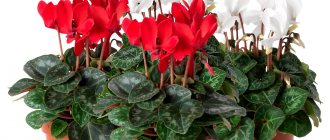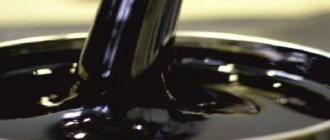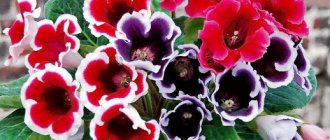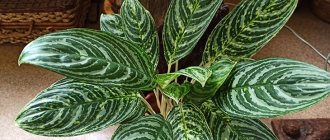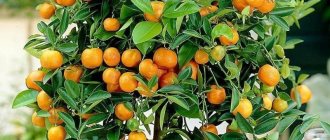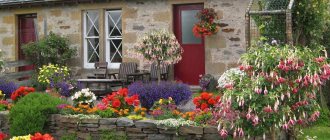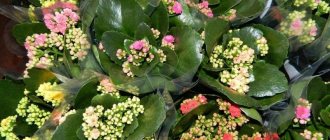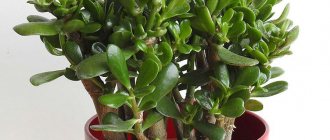Plants that are poisonous and dangerous to humans
Plants that can cause harm to humans belong to the following families:
- Kutrovye are the most harmful house flowers in the world; prominent representatives of the family are: adenium and pachypodium, dipladenia, plumeria, allamanda, strophanthus, carissa. When working with crops, extreme caution should be observed: use rubber gloves, avoid getting poisonous juice on the mucous membrane or skin.
- The aroid family also includes many harmful houseplants: alocasia, aglaonema, monstera, dieffenbachia, philodendron, spathiphyllum, anthurium, syngonium. The toxic effects of individuals are caused by oxalic acid, proteins and enzymes, often used in the manufacture of household chemicals due to their caustic properties.
- Euphorbia flowers (euphorbia, croton, foxtail) contain a poisonous component - euphorin. When the milky juice gets on the skin and mucous membrane, it causes burning, burns and inflammatory processes. You should wash your hands thoroughly after handling the specimen.
Most indoor plants of the Solanaceae family that are harmful to humans (brovallia, brunfelsia, capsicum) are popular among lovers of home floristry. When raising individuals, you should be wary of the internal consumption of poisonous berries of the crop, which cause nausea, vomiting, diarrhea, as well as increased drowsiness and lethargy.
Which house flowers should you be careful with?
Geranium crops captivate with their persistent aroma and bright flowering. Pelargonium leaves contain a high percentage of essential oils that have a beneficial effect on the heart, disinfecting the air, but allergic reactions may occur.
Primrose and calendula affect the mucous membrane, causing acute runny nose, photophobia, poor health, headache, and in more severe cases, asthma attacks.
If you observe an increased threat of poisoning of people and animals, you should remove sources of danger from the apartment.
Rating of poisonous indoor plants
Anthurium
Not the most popular, but a very impressive plant that hides a serious danger behind its bright appearance. If in the case of the azalea you had to taste it, then the anthurium can simply be cut off or transplanted into another pot: the roots of the plant and its juice contain toxic substances, so even if the juice just gets on your skin, you will get a burn. If there are children in the house, this plant should be categorically abandoned.
Plants dangerous to children
Monstera - why you can’t keep it at home and its effect on humans
Potentially dangerous indoor plants (outsiders) for children include:
- Alocasia. The flower contains a burning poison that causes a burn upon contact with the body and instant blindness in the case of the eyes.
- Dieffenbachia. The juice of a tropical crop, when it comes into contact with the skin, causes irritation; in the case of the eyes and oral cavity, there is a high probability of blindness or swelling of the tongue.
- Cactus. It poses a threat to the child due to its thorns, as well as strong hallucinogens, leading to paralysis of the nervous system during flowering.
- Euphorbia plants are fraught with danger in their poisonous milky juice, which causes stomach problems.
- Cyclamen is accompanied by unpleasant consequences for children who prefer to taste everything. Causes nausea, vomiting, stomach upset and diarrhea.
- Clivia contains poison in the stem and base of the leaves. Poisoning is accompanied by salivation, vomiting and diarrhea. Excessive consumption of the juice of the culture threatens collapse and death.
Note! All indoor flowers carry potential harm to the health of children; the task of parents is to protect children from direct contact with home flora.
Poisonous plants to avoid
We've sorted out the energy issue. But there are a number of handsome men who can poison the inhabitants of the rooms.
Detailed list of the most poisonous:
- Dieffenbachia cleanses the air. Violation of the integrity of the leaves is dangerous. Once in the eyes, the juice spoils vision. Irritation appears on the skin. Ingestion leads to systemic disorders.
- Oleander is loved for its beautiful blooms. The aroma makes you dizzy. Inhaling the essential oil contained in oleander is dangerous for your eyesight. The effect of the poison is similar to the most powerful poisonous substances for killing rats.
- Euphorbia poses a threat to the cardiovascular system. Consequences of taking its juice: nausea, vomiting, difficulty breathing, rapid heartbeat, swelling.
- Croton is a miniature tree. Juice is very tricky. If it enters the circulatory system, it can cause death.
- Azalea is a beautiful menace. Its poisons cause diarrhea and convulsions.
- Mimosa pudica produces terrible toxins. After inhaling these, a person can become partially or completely bald.
- Adenium is easy to care for. But it requires caution. The toxicity of adenium is such that the skin becomes covered with red spots and the stomach twists.
- Philodendron also burns with juice. The mucous membranes react sharply to contact.
- Primrose is a terrible allergen during flowering. It is dangerous to inhale the aroma or touch the fibers on the petals.
- Stellera dwarf is poisonous from roots to leaf tips. Eating secretions leads to loss of voice and numbness.
- Nightshade is dangerous due to its fruits. It is not advisable to have it in a house where small children live.
- The Gesner tulip exudes poisonous aromas. If you do not regularly ventilate the room, you will lose some of your hair.
- Alocasia releases cyanide from the damaged root. A large dose is lethal.
- It is forbidden to eat cyclamen. Symptoms of abuse: diarrhea, vomiting, convulsions, loss of consciousness.
- Browallia has poisoned many pets. Completely poisonous.
- Aglaonema surprises with the density of its leaves. Toxic substances are found in fruits and rhizomes.
- Gloriosis causes kidney failure.
- Spathiphyllum causes chronic ulcers on the hands.
- Pouncetia is allergic. If juice enters the esophagus, a serious burn occurs.
- Even the smell of Clivia can harm the process of digesting food.
- Pachypodium Lamera has a trunk that irritates allergy sufferers. Alkaloids burn your eyes. Do not rub your eyelids if you have touched the plant.
- Begonia can be poisonous if you eat a small piece.
Folk signs about indoor plants
Flowering is often associated with income, good luck, and pleasant events on the personal front; withering of plants is considered a bad omen. The exception is the Decembrist - premature or late flowering is considered not the best sign.
Male happiness is a flower that cannot be kept at home
The drying of one plant indicates the removal of a strong evil eye, damage, or serious illness. Mass destruction of crops means the presence of negativity in the apartment or serious damage. Disease and wilting of flowers for natural reasons foreshadows purchases.
If in the middle of winter an inflorescence appears, expected in the summer, something pleasant, and to some extent impossible, will happen. The interpretation is determined by the properties of the culture (the flowering of the money tree out of season means unexpected income).
Important! In Islam, it is forbidden to give plants in flowerpots; the gift threatens failure for the giver and the recipient; when receiving the pot, a coin of any denomination must be given in return. This way the gift will turn into a pleasant purchase.
Plants and superstitions
TOP 5: indoor plants with dangerous energy
Flower growers often do not pay attention to the influence of green pets on the state of the body. But everyone gives the room, and therefore the residents, positive or negative energy. They mindlessly place the pot on the windowsill, then they don’t understand why their head hurts, their tone decreases, and their strength decreases.
“Dangerous” flowers are not always useless. Plants are excellent at drawing out negativity from others. The damage is removed, the evil eye is treated. But after cleansing, they must be taken out of the room.
Cactus
This prickly, unpretentious flower is found in almost every home. You need to be careful when breeding them in your apartment. It is not recommended to have a large amount on the windowsill. They
Cacti provoke:
- insomnia;
- family quarrels;
- nervousness, anxiety;
- low self-esteem.
It is especially not advisable for mammillaria, cereus, and Decembrists to be in the child’s room. There is a great danger that the baby will become disobedient, aggressive, and inattentive.
Place of prickly beauties in the corridor. The benefits are tangible: it will scare away enemies, turn the thief back, and distract spiteful critics.
Monstera
A spreading flower with large leaves is a frequent inhabitant of public buildings, offices, and offices. Beautiful view, but poisonous juice. Causes burns and digestive disorders.
The energetic impact leads to the following:
- feeling exhausted;
- headache;
- malaise;
- surges in blood pressure.
In a house where a monstera grows, long disputes and constant swearing will begin. The more beautiful and spreading the plant, the more complex and difficult the home environment.
Orchid
An unusually charming flower is an energy vampire. Takes strength from the owner. Particularly active at night. If you place the potty in the bedroom, then weakness, weakness, and emptiness in the morning are guaranteed. Every morning he will wake up exhausted and empty.
The place for donated orchids is in the kitchen. Neutralizes the aromas of cooked food. Cannot be placed in the bedroom.
Palm trees
Spreading foliage on a thick base occupies the entire living space. The inhabitants will be plagued by poor health, tearfulness, and depression.
The palm tree is distinguished by a negative biofield that sucks out human potential. Works great in a crowded office, harmonizing the environment.
Ivy
It is not customary to grow vines at home. Climbing plants, according to signs, destroy relationships. In all centuries they have been associated with the dead. Ivy attracts dead energies into space.
The owner of the flower will remain alone until her hair turns gray. If she manages to get married, then her husband will suffer from some kind of addiction.
Flowers of separation and loneliness
What indoor flowers can be kept in the bedroom
According to esotericists, the rating of indoor flowers that cannot be kept at home due to a strong energy field that can make the owner unhappy and lonely is topped by:
- Aloe does not tolerate guests in the house.
- Impatiens has gained the status of the flower of widows and brings lack of money.
- The Decembrist is a muzhegon, a companion of separation and loneliness.
- Cacti cause separation, reduce sexual activity, and deprive you of money.
- Monstera makes the owner lonely and has a negative physiological effect, absorbing oxygen at night and depriving sleep.
It is important to know! Climbing plants and vines are the most powerful muzhegons, depriving girls and women of happiness.
Caution required
The list of not the most useful plants needs to be supplemented. Some are not particularly dangerous. But under certain conditions they can cause harm.
List:
- Lily releases a lot of carbon dioxide at night. It is prohibited to keep in the sleeping room.
- The fern also “breathes” in the dark. Your head will hurt in the morning.
- Ficus is harmful to allergy sufferers.
- Hydrangea is too fragrant. Over time, it provokes the development of allergies.
- Tuberose is contraindicated for heart patients and hypertensive patients.
- Geranium can cause an asthma attack.
- Crassula contains arsenic. An overdose during treatment impairs consciousness.
- Dracaena is slightly toxic. It is advisable not to eat it.
Rules for keeping plants in the house according to Feng Shui
Using the beneficial energy of indoor plants is a simple and aesthetic way to improve your life. Choosing the right place for a flower helps to achieve a state of harmony in all areas of life.
Feng Shui teachings say:
- Fresh plants in the living room attract wealth and good fortune.
- According to Feng Shui, ideal areas for indoor vegetation in a room are niches and corners.
- In the bedroom, flowerpots are placed near the bed at a distance of 1 m.
- Dry or wilting specimens will spell trouble.
- Prickly varieties do not bring benefits to the apartment; it is advisable to plant the plants in the local area, away from the door.
Feng Shui experts raise the question: why should you avoid bushes and trees grown using bonsai technology? The reason is obvious: artificial growth arrest reduces the flow of positive energy into the house.
Plant shape
Upright crops and vines charge the room with health and vigor; vegetation with hanging stems attracts diseases and fatigue. Thorns and thorns are a sign of aggression and conflict. You should avoid planting individuals with leaves that resemble knives or needles.
Color scheme of cultures and feng shui:
- Orange and red colors awaken the passion and sensuality of a beloved man or woman.
- The pink hue evokes empathy and patience.
- White color stimulates spiritual development.
- The yellow tone evokes negative emotions and feelings.
- Blue inflorescences are a source of creative inspiration.
According to the philosophy of Feng Shui, sources of positive energy are geraniums, begonias, Chinese rose, camellia, the list will be successfully complemented by arrowroot and cyclamen.
The best flowers for the home according to Feng Shui
Interactions with human energy
Based on the interaction of flowers with humans at the energy level, indoor plants are divided into 3 groups:
- Powerful protection (cacti, palms, dracaena, yucca). Holders of strong, pronounced “yang” energy are able to protect the home and make a person active and hardworking. It is advisable to install flowerpots in the hall and office, respectively. Placing crops in the bedroom or children's room will have a negative impact.
- Warmth and care (begonia, camellia, hoya, aloe, azalea). The vegetation of the second group has soft “yin” energy. Cultures improve mood, give confidence, help overcome mental and physiological deficiencies, and improve the atmosphere in an unmarried woman’s apartment.
- Space cleaning (ficus, vines, ivy, hibiscus). Plants of the group eliminate geopathogenic zones, remove energy stagnation and protect against the evil eye.
Interesting fact. At the beginning of the 20th century, scientists proved the ability of plants to transmit information and emit light. It has been experimentally proven that flowers perceive verbal threats and promises. For example, Luther Burbank grew a cactus without thorns, guaranteeing the flower reliable protection. According to research, different individuals have different effects on the aura of a room or person.
Is it possible to keep climbing indoor plants at home?
You should not allow plants to climb in your living space - the vines are assigned aggressive masculine energy. Representatives of the stronger half will feel uncomfortable in the space, which is accompanied by a constant desire to leave the room. Ivy and vines suck vitality, optimism and mental health. Keeping plants in the yard, outside the house is beneficial. Cultures look beautiful and protect against the negative emotions of others.
Husbandry plants
Vampire plants
Many types of indoor plants have the ability to absorb negative emotions and protect the health of household members.
Monstera is a “vampire” flower that evokes fear, shock and at the same time feeds on bright positive emotions. The plant is kept in the living room and public spaces where there are a large number of people.
In calm owners, Scindapsus resembles an ordinary vine, also known as epipremnum. For those who like to communicate in raised voices, bindweed will grow into a lush jungle.
Chlorophytum neutralizes negative emotions caused by problems at work, financial difficulties and fatigue after shopping or watching videos. It is also useful for children, after talking with their peers, to spend half an hour on the plant: moisten, loosen, cut off old leaves. Variegated chlorophytum is recommended for older people; the individual takes away negative energy, providing a calming effect.
Important! Ferns are successfully used in rooms with the maximum release of energy: offices, theater foyers, home living rooms with a TV. The plant feels comfortable in diffused light, near a source of energy surge (TV, large household appliances, active employees).
Orchids make a huge contribution to heated disputes, passions, and console those who cry. Seeing the exquisite flowering, people involuntarily think about the beauty of the world, about spirituality, and harmony.
Sheflera is useful for schoolchildren and students immersed in mental and creative work. Culture promotes collaboration, inspiration and learning.
Asparagus absorbs the energetic manifestation of weakness, lack of will, and laziness. Suitable for people involved in business, creativity and sports.
Sansevieria feeds on strong electromagnetic radiation generated by household or office equipment and does not respond to subtle energies; one should not expect a calming effect from the plant.
Beware, vampire flowers
Many plants are poisonous and dangerous, but most are successfully cultivated by people. It may be worth avoiding buying a flower that could harm your household. However, when deciding to grow potentially hazardous crops, every effort should be made to reduce the risk. Children and animals (cats, dogs) should not be allowed to come into contact with the crop, place beds nearby, and rubber gloves should be used when working with the specimen. Following simple rules will reduce the threat and allow you to enjoy the natural beauty of plants.
